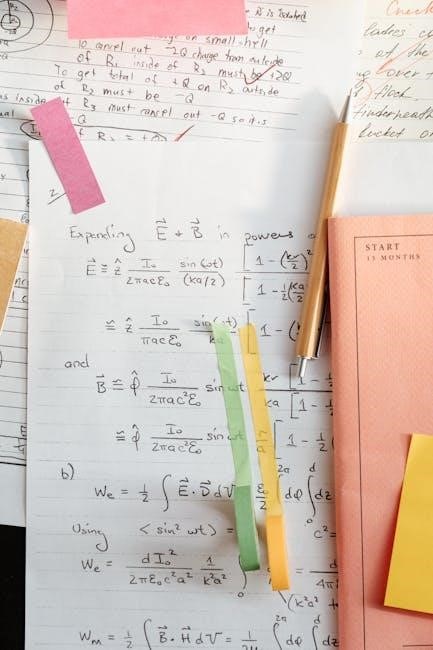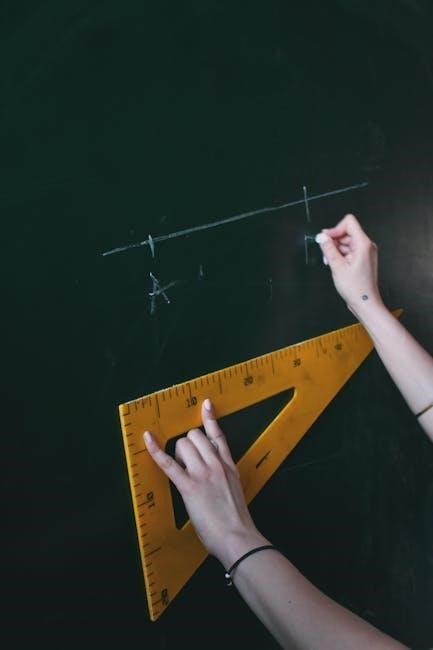This geometry problems and solutions PDF offers a comprehensive resource with step-by-step solutions to various geometry problems, covering conic sections, computational geometry, and more. It’s free to download and ideal for learners of all levels, providing clear explanations and detailed answers to enhance understanding and problem-solving skills.
Overview of Geometry and Its Importance
Geometry is a fundamental field of mathematics that studies shapes, sizes, and spatial relationships, offering essential tools for problem-solving. It is crucial in various real-world applications, such as engineering, architecture, and physics. The study of geometry enhances logical reasoning, critical thinking, and visual perception. By understanding geometric principles, learners can tackle complex problems involving conic sections, polygons, and 3D structures. Geometry also fosters creativity and analytical skills, making it a cornerstone of STEM education. Its importance extends to art, design, and everyday problem-solving, providing a universal language for describing the world around us.
Why Use PDF Resources for Geometry Problems?
PDF resources for geometry problems are highly accessible and portable, allowing learners to study anywhere, anytime. They offer comprehensive collections of problems with detailed solutions, ideal for self-study or classroom use. PDFs are universally compatible across devices and provide a structured format for understanding complex geometric concepts. Many resources are available for free download, making them cost-effective. They often include step-by-step explanations, diagrams, and practice exercises, catering to learners of all levels. PDFs also ensure that content remains unchanged and easily sharable, making them a reliable choice for mastering geometry skills and preparing for exams or competitions.
Key Features of Geometry Problems and Solutions PDFs
Geometry problems and solutions PDFs offer a wealth of resources for learners, featuring detailed explanations and step-by-step solutions to various geometry problems. Many PDFs are free to download, providing cost-effective access to high-quality educational content. They often include diagrams, visual aids, and practice exercises, making complex concepts easier to grasp. These resources cover a wide range of topics, from basic properties of circles, triangles, and polygons to advanced conic sections and 3D geometry. The solutions are concise yet thorough, ensuring learners can follow along without gaps in understanding. Additionally, PDFs are portable and accessible on multiple devices, making them ideal for self-study or classroom use. They also cater to different skill levels, from AMC-level problems to IMO Shortlist challenges.

Types of Geometry Problems
Explore various types of geometry problems, including analytic, synthetic, planar, and coordinate geometry, each offering unique challenges and requiring different problem-solving approaches and techniques.
Analytic Geometry Problems
Analytic geometry problems involve solving geometric questions using algebraic methods and coordinate systems. These problems often require calculating distances, slopes, and equations of lines, circles, and other shapes. By applying coordinate geometry principles, students can determine properties like midpoints, intersections, and areas. Analytic geometry is particularly useful for solving real-world problems, such as determining the shortest path between points or calculating the trajectory of moving objects. It emphasizes logical reasoning and precise calculations, making it a foundational tool in mathematics and its applications. Practicing analytic geometry problems helps develop problem-solving skills and prepares students for advanced topics in mathematics, physics, and engineering.
Synthetic Geometry Problems
Synthetic geometry problems focus on solving geometric questions using axioms, theorems, and deductive reasoning without relying on coordinate systems. These problems often involve proving properties, congruencies, and similarities of shapes. Key topics include triangle congruence, circle theorems, and properties of polygons. Synthetic geometry emphasizes geometric intuition and logical flow, often requiring the construction of auxiliary lines or points to simplify proofs. Classic problems include proving the Pythagorean theorem, establishing the properties of parallel lines, and demonstrating the congruence of triangles. This approach fosters deep understanding of geometric relationships and logical reasoning skills. Synthetic geometry is particularly valued in mathematical competitions and for developing rigorous proof-writing abilities.
Planar Geometry Problems
Planar geometry problems involve studying geometric figures confined to a two-dimensional plane. These problems focus on properties and relationships of points, lines, angles, polygons, circles, and other shapes within a flat surface. Key topics include calculating distances, areas, and perimeters, as well as understanding congruency, similarity, and symmetry. Planar geometry is foundational for solving practical problems in architecture, engineering, and design. Resources like geometry problems and solutions PDFs often feature exercises on planar geometry, offering step-by-step explanations for concepts like triangle properties, quadrilateral theorems, and circle measurements. These materials are invaluable for students and professionals seeking to master two-dimensional geometric principles and their applications.
Coordinate Geometry Problems
Coordinate geometry problems involve solving geometric questions using algebraic methods within a coordinate system. These problems often focus on finding distances, slopes, and equations of lines, as well as intersections and midpoints. Key concepts include plotting points, analyzing shapes, and applying formulas like the distance formula and midpoint formula. Coordinate geometry is widely used in physics, engineering, and computer graphics. Geometry problems and solutions PDFs frequently include exercises on coordinate geometry, providing step-by-step explanations for topics like circle equations, parabolas, and systems of equations. These resources are essential for students mastering coordinate geometry, offering practical examples and solutions to complex problems, making them ideal for exam preparation and skill enhancement.

Popular Geometry Problem Topics
Popular geometry topics include circles, triangles, polygons, and conic sections, each with unique properties and applications.
Circles and Their Properties
Circles are fundamental in geometry, defined as sets of points equidistant from a center. Their properties include circumference (2πr), area (πr²), and relationships like radius and diameter. Key theorems involve angles subtended by arcs, with tangent and chord properties. Problems often involve calculating areas, circumferences, or proving theorems about arcs, chords, and angles. These concepts are essential for advanced topics and real-world applications.
Triangles and Their Properties
Triangles are three-sided polygons with properties crucial in geometry. Types include equilateral, isosceles, and scalene, based on side lengths, and acute, right, and obtuse, based on angles. Key properties involve the Pythagorean theorem for right triangles, triangle inequality, and Heron’s formula for area calculation. Essential concepts like congruence (SAS, SSS, ASA, AAS) and similarity (AA, SSS, SAS) are foundational. Theorems such as the Law of Sines and Cosines extend applicability. These properties form the core of geometry problems, with solutions often requiring proof or calculation. PDF resources provide detailed explanations and examples, making triangles a cornerstone of geometry study and problem-solving;
Polygons and Their Properties
Polygons are multi-sided figures with straight sides and angles. Regular polygons have equal sides and angles, while irregular polygons do not. Key properties include the number of sides, angles, and vertices. The sum of interior angles is calculated using the formula ((n-2) imes 180^ rc), where (n) is the number of sides. Exterior angles sum to (360^ rc). Common polygons include pentagons, hexagons, and octagons. Properties like symmetry and diagonals are essential for solving problems. PDF resources provide detailed solutions, often with diagrams, for calculating perimeter, area, and angle measures. These problems enhance spatial reasoning and mathematical precision, making polygons a fundamental topic in geometry studies and problem-solving exercises.
Conic Sections and Their Properties
Conic sections are curves formed by the intersection of a plane with a double-napped cone. The primary types are circles, ellipses, parabolas, and hyperbolas. Each has unique properties, such as foci, directrices, and asymptotes. Circles are special cases of ellipses with equal axes, while hyperbolas have two separate branches. Key properties include equations, symmetry, and geometric definitions. For example, an ellipse is the set of points where the sum of distances to two foci is constant. These shapes are crucial in geometry, with applications in astronomy and engineering. PDF resources provide detailed problems and solutions, helping learners master conic sections through step-by-step explanations and visual diagrams, enhancing understanding of their equations and real-world applications.

Advanced Geometry Topics
Advanced geometry topics explore complex concepts like 3D shapes, fractals, and real-world applications. PDF resources offer detailed problems and solutions, aiding learners in mastering these areas through practical examples and visual aids, making abstract ideas tangible.
3D Geometry and Its Applications
3D geometry explores the properties and relationships of three-dimensional shapes, such as cubes, pyramids, and spheres. It involves understanding concepts like volume, surface area, and spatial reasoning. PDF resources provide comprehensive problem sets and solutions, helping learners master 3D geometry through practical examples. Applications of 3D geometry are vast, including engineering, architecture, computer graphics, and physics. These resources often include visual aids and step-by-step explanations, making complex spatial relationships easier to grasp. By solving problems in 3D geometry, students develop critical thinking and problem-solving skills, essential for real-world applications. Detailed solutions in PDFs ensure clarity and deepen understanding of this fundamental area of mathematics.
Fractals and Self-Similar Shapes
Fractals and self-similar shapes are intricate geometric patterns that repeat themselves at different scales, often exhibiting infinite complexity. These shapes, like the Mandelbrot set or Sierpiński triangle, are fundamental in understanding chaos theory and natural phenomena. PDF resources dedicated to geometry problems and solutions provide in-depth explorations of fractals, offering challenges to calculate dimensions, identify patterns, and visualize recursive structures. These materials often include high-resolution images and step-by-step solutions, making abstract concepts accessible. Fractals also find applications in art, biology, and computer science. Solving problems involving fractals enhances spatial reasoning and mathematical intuition, preparing learners for advanced topics in geometry and its real-world applications.
Geometry in Real-World Applications
Geometry plays a vital role in real-world applications, from architecture to engineering. PDF resources on geometry problems and solutions highlight practical uses, such as designing buildings, bridges, and electronic circuits. Computer graphics and gaming rely on geometric principles for 3D modeling and animation. GPS technology uses geometric concepts like trilateration for precise location tracking. Medical imaging, such as MRI and CT scans, employs geometry to create detailed body images. Art and science also benefit, as geometric patterns inspire designs and help understand molecular structures. These resources often include problems that simulate real-world scenarios, enabling learners to apply geometric concepts to practical challenges. Solving these problems fosters critical thinking and prepares individuals for careers in diverse fields.

Notable Geometry Problem Books and Resources
Notable geometry problem books include: 100 Geometry Problems by David Altizio and Alvin Zou, Solving Problems in Geometry by V. Gusev, V. Litvinenko, and A. Mordkovich, and The Priceless Treasures of Elementary Geometry. These resources provide comprehensive problem sets with detailed solutions, ideal for students and enthusiasts seeking to master geometric concepts.
“100 Geometry Problems by David Altizio, Solutions by Alvin Zou”
100 Geometry Problems by David Altizio, Solutions by Alvin Zou is a highly regarded resource for geometry enthusiasts. This book offers a diverse range of geometry problems, from foundational concepts to advanced challenges, making it suitable for students at various skill levels. The problems are thoughtfully curated to encourage deep understanding and creative problem-solving. Alvin Zou’s detailed solutions provide clear, step-by-step explanations, helping learners grasp complex ideas. The collaborative effort between Altizio and Zou ensures a balanced approach, blending problem-solving techniques with rigorous mathematical reasoning. This resource is particularly valuable for those preparing for competitions or seeking to strengthen their geometry skills. Its PDF availability makes it easily accessible for widespread use.
“Solving Problems in Geometry by V. Gusev, V. Litvinenko, A. Mordkovich”
“Solving Problems in Geometry” by V. Gusev, V. Litvinenko, and A. Mordkovich is a comprehensive guide designed to enhance problem-solving skills in geometry. This resource is tailored for students seeking to master various geometric concepts through detailed explanations and practice problems. The book covers a wide range of topics, from basic principles to advanced geometric theories, ensuring a gradual learning curve. Each problem is accompanied by step-by-step solutions, making it easier for learners to understand and apply geometric principles. The collaborative effort of the authors brings diverse perspectives, enriching the content with practical examples and real-world applications. This PDF is an invaluable tool for self-study, offering clarity and depth in every section.
“The Priceless Treasures of Elementary Geometry”
“The Priceless Treasures of Elementary Geometry” is a unique collection of geometric problems and solutions designed to inspire and challenge learners. This PDF resource focuses on foundational concepts, presenting them in an engaging and accessible manner. It covers essential topics such as points, lines, circles, triangles, and polygons, with a emphasis on visual and intuitive approaches. The book includes classic problems alongside modern variations, encouraging creative thinking and problem-solving skills. Step-by-step explanations and proofs are provided for each problem, making it ideal for self-study or classroom use. Its clarity and depth make it a valuable resource for students and geometry enthusiasts alike, fostering a deeper appreciation for the beauty of geometry.

Geometry Problem Solutions and Explanations
Discover clear step-by-step solutions and detailed explanations for various geometry problems. This section provides visual aids, proofs, and multiple methods to enhance understanding and problem-solving skills effectively.
Step-by-Step Solutions for Common Geometry Problems
Step-by-step solutions provide a structured approach to solving geometry problems, breaking down complex concepts into manageable parts. Each solution begins with understanding the problem, followed by identifying key geometric principles, and applying relevant theorems or formulas. Clear diagrams and visual representations are often included to illustrate spatial relationships and simplify calculations. Detailed explanations accompany each step, ensuring clarity and reinforcing understanding. These solutions cover a wide range of topics, from basic triangle properties to advanced conic sections. By following these guides, learners can develop problem-solving strategies, improve their spatial reasoning, and build confidence in tackling geometry challenges. Additional practice exercises are also provided for reinforcement.

Video Tutorials and Visual Explanations
Video tutorials offer an engaging way to learn geometry by providing visual and auditory explanations of complex problems. Platforms like YouTube, Khan Academy, and GeoGebra host extensive libraries of geometry lessons. These tutorials often include animations, real-time problem solving, and interactive simulations to help students grasp spatial relationships and geometric principles. Many videos are paired with PDF resources, allowing learners to follow along with step-by-step solutions. Visual explanations are particularly effective for understanding concepts like conic sections, 3D geometry, and fractals. They also cater to different learning styles, making abstract ideas more accessible. Additionally, video tutorials enable learners to pause, rewind, and replay content, fostering a self-paced learning environment.
Interactive Tools for Solving Geometry Problems
Interactive tools like GeoGebra, Desmos, and online geometry editors allow students to explore and solve geometry problems dynamically. These tools enable users to create and manipulate shapes, measure angles and distances, and visualize geometric transformations in real-time. Many PDF resources are complemented by links to these digital platforms, enhancing problem-solving experiences. Interactive tools foster deeper understanding by letting learners experiment with variables and observe outcomes immediately. They also support collaborative learning, as students can share their constructions and solutions online. Such tools are invaluable for both beginners and advanced learners, making geometry more engaging and accessible. They bridge the gap between theoretical concepts and practical application, promoting a hands-on approach to problem-solving.

Geometry Challenges and Competitions
Engage in AMC and IMO-level geometry contests to sharpen problem-solving skills. PDF resources provide ample practice problems and solutions to aid in competition preparation effectively.
AMC-Level Geometry Problems
AMC (American Mathematics Competitions) geometry problems are renowned for their challenging nature, requiring precise spatial reasoning and theorem application. These problems often involve triangles, circles, and coordinate geometry, testing a student’s ability to synthesize concepts. Solutions in PDF formats provide detailed explanations, enabling learners to grasp complex strategies. Regular practice with AMC-level problems enhances problem-solving agility and prepares students for higher-level competitions. The structured format of these resources ensures comprehensive understanding, making them invaluable for exam preparation and skill refinement.
IMO Shortlist-Level Geometry Problems
IMO shortlist-level geometry problems represent the pinnacle of challenging geometry questions, often requiring advanced techniques and deep conceptual understanding. These problems frequently involve intricate configurations, such as triangle geometry, circle theorems, and synthetic methods. PDF resources containing these problems and their solutions are invaluable for high-level preparation, offering insights into non-routine problem-solving strategies. Students engaging with these materials must think creatively, applying multiple theorems and properties in innovative ways. The solutions provided in these PDFs not only explain the steps but also highlight key insights and alternative approaches. Regular study of these problems significantly enhances spatial reasoning and problem-solving agility, preparing students for the most demanding competitions.
Geometry Challenges for Talented Students
Geometry challenges for talented students are designed to push the boundaries of problem-solving skills, catering to those with a strong aptitude for spatial reasoning and mathematical thinking. These challenges often involve complex, non-routine problems that require creativity and a deep understanding of geometric principles. PDF resources dedicated to these challenges provide a curated selection of problems, ranging from combinatorial geometry to advanced 3D geometry, along with detailed solutions. They are ideal for students preparing for prestigious competitions or seeking to expand their problem-solving horizons. Regular engagement with such materials fosters a higher level of mathematical sophistication and prepares students for the most challenging academic and competitive environments.

Learning Resources and Study Materials
Learning resources and study materials for geometry include PDF guides, interactive tools, and online platforms offering step-by-step solutions and visual aids for better understanding.

Free PDF Downloads for Geometry Problems
Free PDF downloads for geometry problems offer a cost-effective way to access high-quality resources. These PDFs often include a wide range of geometry problems, from basic to advanced levels, covering topics like triangles, circles, polygons, and 3D shapes. Many resources provide detailed solutions, making them ideal for self-study or classroom use. Websites like educational portals, open-source platforms, and academic repositories offer these PDFs. Some popular downloads include problem sets with visual diagrams, step-by-step explanations, and practice exercises tailored for competitions or exams. These resources are particularly beneficial for students, teachers, and enthusiasts seeking to improve their geometry skills without financial barriers. They are easily accessible and printable, ensuring convenience for learners worldwide.
Online Communities and Forums for Geometry Enthusiasts
Online communities and forums provide vibrant spaces for geometry enthusiasts to engage, learn, and share knowledge. Platforms like Stack Exchange, Reddit, and specialized math forums host discussions on geometry problems, solutions, and resources. These communities allow users to ask questions, share insights, and collaborate on challenging problems. Many forums feature dedicated threads for geometry, where participants can access shared resources, including PDF guides and problem sets. Additionally, these spaces often include interactive tools, live problem-solving sessions, and peer reviews. Such communities foster a supportive environment for learners at all levels, from beginners exploring basic concepts to advanced geometers tackling complex theories. They also serve as hubs for discovering new resources and connecting with like-minded individuals worldwide.
Diagnostic Tests and Pre-Assessment Tools
Diagnostic tests and pre-assessment tools are essential for evaluating students’ understanding of geometry before diving into detailed problem-solving. These resources, often included in geometry problems and solutions PDFs, help identify knowledge gaps and skill levels. They typically feature multiple-choice questions, short-answer problems, and visual exercises to assess mastery of concepts like angles, triangles, and polygons. Many PDFs include answer keys and explanations, allowing learners to review and improve independently. These tools are particularly useful for teachers to tailor lessons to class needs and for students to pinpoint areas requiring extra practice. Regular use of diagnostic tests ensures a strong foundation before tackling advanced geometry challenges, making them a valuable component of any learning strategy.

